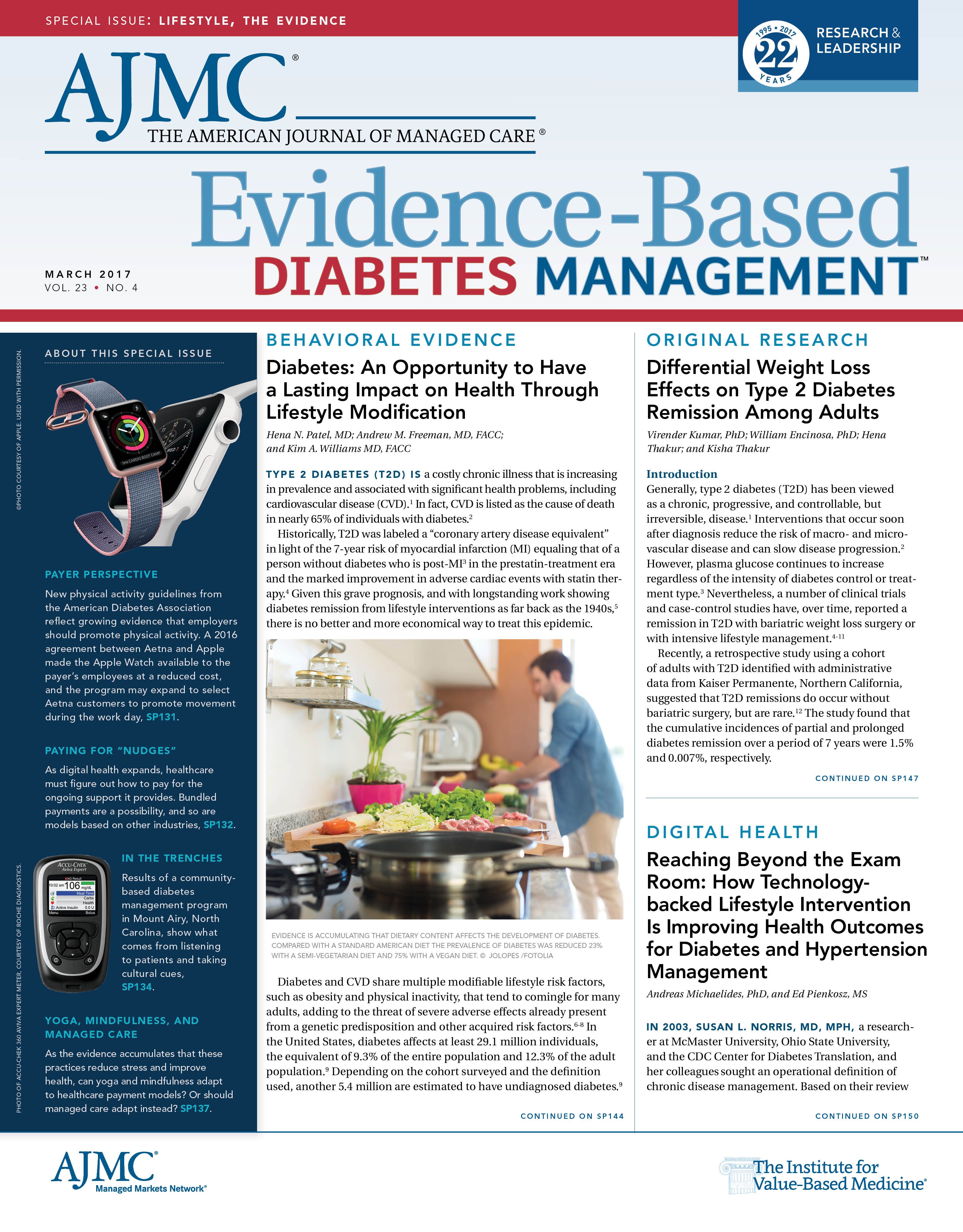Publication
Article
Evidence-Based Diabetes Management
A Bundle of Nudges: Healthcare Payment in an Era of Behavioral Science
Author(s):
Using digital health to manage chronic disease means creating new payment models that recognize care is an ongoing process.
According to the CDC, the majority of deaths in the United States are due to diseases that are largely preventable.1 Chronic diseases, such as diabetes, certainly have genetic components, but their etiology is also profoundly behavioral—driven by choices that individual patients make on a day-by-day, minute-by-minute basis.
A great deal of research has been done on maladaptive behaviors that people exhibit in the near term, even when they know that a different choice is best for the long term.2 This phenomenon is accentuated among people facing alternatives that involve an addictive choice like alcohol3 or sugar.4 These choices often are informed by cognitive biases, notably attentional bias5 and evaluative bias.6
Richard Thaler and Cass Sunstein’s behavioral economics book Nudge is a broad romp through social policies that can influence a wide range of human behaviors to help people overcome cognitive biases.7 The general point of the book—that behavioral science can and should be used to guide the libertarian free choices of people to better outcomes in the face of cognitive biases—has profound implications for healthcare in a world in which an increasing proportion of health gains are being pursued through behaviorial change and maintenance.
Progressive thinkers in healthcare are certainly on the case. Health and medical services that provide continuous, on-demand care, or “nudges” to behaviors associated with chronic disease, are proliferating, often facilitated by information technology and accompanied by published clinical results. There are simple care process improvement nudges to remind patients of immunizations, like Voxiva’s text service, which was shown to produce a 30% improvement in influenza vaccination rates among women.8
In another example, more focused on direct delivery of “care nudges,” Virta Health’s Diabetes Reversal Clinic provides consistent personalized, electronically delivered nudges—the frequency of which vary—to individuals with type 2 diabetes (T2D) from Virta physicians and health coaches. Virta also provides personalized education to patients on a daily basis. Recent data show that the clinic achieved a 54% reversal of diabetes among its patients with T2D in just 70 days.9
Most people believe that technology-enabled nudges make up the care model they need to address chronic disease. But traditional payment schemes for healthcare are ill-equipped to properly reimburse for nudge-based care, as recognized by many, including a recent, high-profile panel at the J.P. Morgan Healthcare Conference.10 Traditional fee-for-service (FFS) models provide reimbursement for relatively long and in-person—or, as of late, telemedicine—visits. For example, in a model in which a Virta health coach contacts a patient 3 times a day with small nudges, it is administratively burdensome and overly costly to submit 3 insurance claims because of the $8-per-claim cost for such expenses as software/hardware, processing, and back-end collections.11 On average, Virta and its patients interact 13 times per week; under a FFS model, submitting claims at this rate would not be practical in this case.
Furthermore, many rigorous health services for chronic conditions now involve contacting patients through intelligent technology rather than having a clinician manually execute all efforts involved in the interaction. For example, ginger.io, an online care service to combat depression and anxiety, uses machine learning to evaluate device sensor data and patient survey responses to support the provision of more personalized care.12 The sensor and survey data are often supplied many times per day. In a FFS world in which there are only codes for medical devices and human—clinician visits, there are few, if any, codes that exist for these frequent high-value patient touchpoints driven by technology rather than humans.
Like ginger.io, the Virta model is a particularly challenging one for a FFS environment, since it involves a broad variety of touchpoints with patients: clinician interaction, technology-personalized educational curriculum delivered via text and video, and measurement and tracking of patient biometrics. Virta touchpoints with patients also happen both real-time as well as asynchronously in an online chat-style interface, allowing the patient to engage whenever it is convenient for them. Applying a FFS claims approach to this care setting would lead to drastic underappreciation of the value provided by the Virta Diabetes Reversal Clinic. These are just 2 examples, of many. Rock Health, a venture fund dedicated to digital health, notes that of 300 digital health funding deals executed in 2016, 15% were investments into nudge-based care companies.13
There are 2 potential solutions here:
• Per nudge: reformulate coding rules to allow the creation of codes for nudges as outlined above and to reduce claims transaction costs to pennies. To use a music payment analogy, this is the “pay per song” model espoused for a decade by Apple.
• Bundle of Nudges: providers get no reimbursement for individual nudges; they are paid a per-patient amount for a bundle of services to be provided, preferably with payment based on agreed-upon clinical outcomes achieved by the nudges, rather than just payment for the bundle of nudges itself. In effect, this is a value-based bundled payment model similar to the Comprehensive Care for Joint Replacement model tested by Medicare for knee and hip-replacement surgery—but applied to treatment for chronic care.
The Bundle of Nudges approach is a clearly preferable model. It does not require massive overhaul of claims systems or FFS coding rules and it allows for further innovation and application of technology to the achievement of desired behavioral change and mod-ification. So what is standing in the way of a Bundle of Nudges payment from catching on? Three key hurdles must be overcome.
First, health insurance carrier leaders must embrace the idea that technology-enabled remote healthcare services can be as good as, or better than, in-person versions of similar programs, especially in disease states for which nudge-based approaches are considered standard-of-care. A recent example of a large payer ignoring such an undeniable trend can be seen in CMS’ decision not to reimburse for digitally delivered Diabetes Prevention Programs (DPPs) during year 1 of coverage under the new Medicare Diabetes Prevention Program (MDPP)14 despite the existence of quality data from DPP providers, such as Omada Health.15 This regrettable decision by CMS is a setback, but should not deter the proliferation of technology-enabled, nudge-based healthcare services. Insurers in private markets are leading the way by agreeing to work with such companies,16 and digital providers have organized under the Council for Diabetes Prevention17 to press Medicare to include them when MDPP reimbursement rules are finalized later this year.
Second, we must agree on the clinical outcome that the nudges are intended to achieve and for which providers of nudge-based care models—like Virta—will be reimbursed. In the area of diabetes, Virta’s model is to get paid if, and only if, specific HbA1c targets are achieved and/or maintained. Although this may seem like common sense, agreement on value-based clinical metrics is hard to achieve in healthcare, so visionary health plan leaders need to “put a stake in the ground” on what good management of chronic disease looks like from an outcomes perspective.
Third, health insurance carriers must pave the way for speedy signing of contracts using Bundle of Nudges schemes. Currently, most health plans have a provider network contracting group that is responsible for signing FFS network contracts and a medical management group that is responsible for evaluating more innovative models, like bundled-payment models. The problem is, the medical management groups are often not empowered or incentivized to sign these bundled-payment contracts quickly since they are new and untested. However, most health plan senior executives still say that bundled and value-based payment models, like the Bundle of Nudges concept, are the wave of the future.18
This is a particular challenge since many nudge-based treatment approaches are being pioneered by small companies, like Virta Health, that do not have the financial luxury of waiting 5 years to be evaluated and go through the tedious process of securing a bundled payment contract from large health plans. This shorter-term view should not make insurance carriers skittish, however. In general, there are surrogate endpoints for chronic healthcare services, measured at 6-12 months, that can act as reliable statistical proxies for longer-term outcomes. For example, reduction in HbA1c in Virta’s clinic has been shown to be highly correlated to 12-month HbA1c and diabetes reversal outcomes and is thus a valid proxy.19 Insurance carriers need to make it easier for the best of these innovators to secure bundled contracts quickly.
If we are to truly address chronic diseases that have become the largest medical scourge of today’s society, we need technology-enabled, nudge-based care to become prevalent. That, in turn, requires health insurance carriers to develop models beyond classic FFS schemes to reimburse bundles of nudges and to make the new bundled-payment schemes quickly available to the clinical innovators, like Virta, that are demonstrating the immense value and potential of nudge-based approaches.
Author Information: Mike Payne, MBA, MSci, is currently head of commercial and policy at Virta Health. He last served as chief commercial officer and head of medical affairs at Omada Health. Previously, he worked at Gilead Sciences, Accenture, and McKinsey & Company. References
1. Up to 40 percent of annual deaths from each of 5 leading US causes are preventable [press release]. Atlanta, GA: CDC; May 1, 2015. https://www.cdc.gov/media/releases/2014/ p0501-preventable-deaths.html. Accessed January 17, 2017.
2. Wiers RW, Gladwin TE, Hofmann W, Salemink E, Ridderinkhof KR. Cognitive bias modification and cognitive control training in addiction and related psychopathology. Clin Psychological Science. 2013;1(2):192-212.
3. Hofmann W, Friese M. Impulses got the better of me: alcohol moderates the influence of implicit attitudes toward food cues on eating behavior. J Abnorm Psychol. 2008;117(2):420- 427. doi: 10.1037/0021-843X.117.2.420.
4. Avena NM, Rada P, Hoebel B. Evidence for sugar addiction: behavioral and neurochemical effects of intermittent, excessive sugar intake. Neurosci Biobehav Rev. 2007;32(1):20-39. doi: 10.1016/j.neubiorev.2007.04.019.
5. Field M, Cox WM. Attentional bias in addictive behaviors: a review of its development, causes, and consequences. Drug Alcohol Depend. 2008;97(1-2):1-20. doi: 10.1016/j.drugalcdep. 2008.03.030.
6. Bradley B, Field M, Mogg K, De Houwer J. Attentional and evaluative biases for smoking cues in nicotine dependence: component processes of biases in visual orienting. Behav Pharmacol. 2004;15(1):29-36.
7. Thaler RH, Sunstein CR. Nudge Improving Decisions about Health, Wealth, and Happiness. New York, NY: Penguin Books; 2009.
8. Stockwell MS, Westhoff C, Kharbanda EO, et al. Influenza vaccine text message reminders for urban, low-income pregnant women: a randomized controlled trial. Am J Pub Health. 2014;104(S1): e7-e12. doi: 10.2105/AJPH.2013.301620.
9. Results to be published in February 2017.
10. Preston J. Many healthcare technologies are married to the fee-for-service model. MedCityNews website. http://medcitynews.com/2017/01/many-healthcare-technologies-married- fee-service-model/. Published January 10, 2017, Accessed January 17, 2017.
11. Thorman C. Should you outsource your medical billing? The Profitable Practice website. http://profitable-practice.softwareadvice.com/when-should-you-outsource-your-medicalbilling- 1032610/. Published March 6, 2010. Accessed January 17, 2017.
12. Captain S. Can artificial intelligence help the mentally ill? Fast Company website. https://www.fastcompany.com/3059995/mind-and-machine/can-artificial-intelligence-help-the-mentally-ill. Published July 21, 2016. Accessed January 17, 2017.
13. Digital health funding database, 2016. Rock Health website. https://rockhealth.com/data/funding-raw-data/. Accessed January 17, 2017.
14. Centers for Medicare & Medicaid Services. Medicare Diabetes Prevention Program (MDPP) Expanded Model. CMS website. https://innovation.cms.gov/initiatives/medicare- diabetes-prevention-program/. Updated December 13, 2016. Accessed January 17, 2016.
15. Sepah SC, Jiang L, Peters AL. Long-term outcomes of a web-based diabetes prevention program: 2-year results of a single-arm longitudinal study. J Med Internet Res. 2015;17(4):e92. doi: 10.2196/jmir.4052.
16. AMA, Omada Health, Intermountain Healthcare partner to reduce incidence of type 2 diabetes [press release]. Chicago, IL; San Francisco, CA; and Salt Lake City, UT: Omada Health; July 26, 2016. https://www.omadahealth.com/news/ama-omada-health-intermountain-healthcare-partner-to-reduce-incidence-of-type-2-diabetes. Accessed January 17, 2017.
17. Council for Diabetes Prevention launched to support delivery of CDC National Diabetes Preventino Program [press release]. Washington, DC: Marketwired; September 21, 2016.
http://www.marketwired.com/press-release/council-diabetes-prevention-launched-support-delivery-cdc-national-diabetes-2160355.htm. Accessed January 10, 2017.
18. Beck M. Hospitals push bundled care as the billing plan of the future. The Wall Street Journal website. http://www.wsj.com/articles/hospitals-promote-bundled-payments-asthe- wave-of-the-future-1402067196. Published June 4, 2014, Accessed January 17, 2017.
19. Virta Health Inc. Internal data.

Newsletter
Stay ahead of policy, cost, and value—subscribe to AJMC for expert insights at the intersection of clinical care and health economics.





